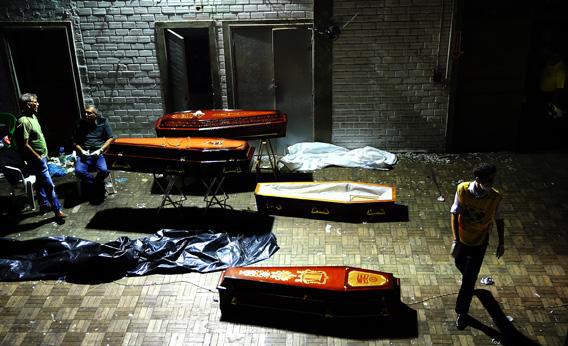A nightclub fire in Santa Maria, Brazil, claimed more than 230 lives Sunday. The fire resulted from a pyrotechnics display that was part of a country-pop band’s performance. Who were the first musicians to use pyrotechnics in their concerts?
The Crazy World of Arthur Brown, a British psychedelic band, was one of the first. When performing the band’s 1968 hit, “Fire,” Brown wore a flaming helmet and a painted face while proclaiming himself “the god of hellfire” and crooning lyrics such as “You’re going to burn.” Brown’s pyrotechnics were small-scale and careless by later standards—his homemade helmet consisted of a bowl of gasoline welded to a cap, and Brown suffered from injuries while testing different versions of it.
Pink Floyd was probably the first band to use pyrotechnics on a grand scale. As part of the psychedelic band’s 1973 tour for The Dark Side of the Moon, a model plane crashed into the stage and exploded. Explosions featured heavily on the band’s other tours—the band was known to blow up beds, gongs, and inflatable pigs during concerts—along with other fiery effects, like pyrotechnic waterfalls.
But it was heavy metal bands in the 1970s and 1980s that professionalized musical pyrotechnics and brought them to new heights. Kiss, whose members had performed fire-breathing stunts in early performances in New York City, revolutionized the arena tour with three-dimensional theatrics and pageantry, which included face makeup evocative of Brown’s and pyrotechnics on a much larger scale. Other heavy metal groups such as Iron Maiden and Judas Priest adopted similar pyrotechnic regimes. Pyrotechnics, with their implicit danger, aligned well with heavy metal’s darker themes and imagery, including hellfire, brimstone, and death. But pyrotechnics and other special effects were soon adopted by mainstream pop musicians who played arena tours as well as other entertainers that performed in those venues. Pyrotechnics became a staple of professional wrestling matches, rodeos, and monster truck rallies in the 1980s and 1990s.
The early days of pyrotechnics did not pass without injury. Perhaps most famously, Michael Jackson’s hair caught on fire while filming a Pepsi commercial in front of a live audience in 1984. Blackie Lawless, the lead singer of the hair band W.A.S.P., used to perform wearing a flaming codpiece, which once exploded, burning the hair off his legs. Metallica singer James Hetfield suffered severe burns from a pyrotechnic accident during a concert in Montreal in 1992. Pyrotechnics first caused a fatal fire in 2003, when the Station nightclub in West Warwick, R.I., burned during a performance of the heavy metal band Great White; that fire killed 100 people. A pyrotechnic flare caused another nightclub fire that killed 194 people in Buenos Aires, Argentina, in 2004.
Got a question about today’s news? Ask the Explainer.
Explainer thanks Ian Christe of Bazillion Points Books, Jeffrey Pearlin, and Sharon Stancavage of Strictly FX.
